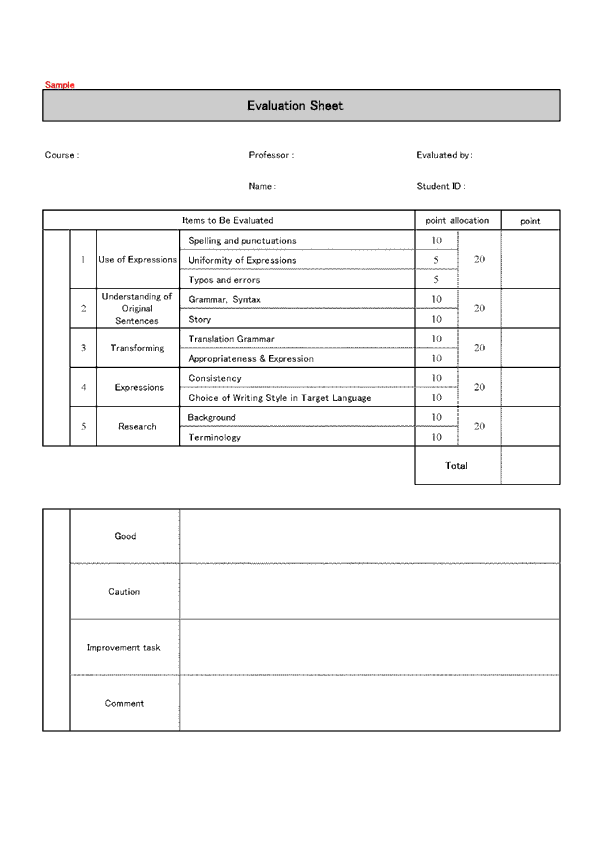| Course Syllabus |
|
Course Name |
Translation Grammar: Basic Rules (Course No:51101)
|
|
Category |
Language Competence |
| Year Taken |
First Year |
| Offered Major / Type of Course |
All Majors/ Required |
| Number of Credits |
1 |
| Number of Classes |
8
|
| Professor |
Yasushi Shibata
Email address: yasushi.s@babel.edu |
| Course Description |
Introduces students to basic translation techniques by using BABEL Translation Grammar Rules.
|
| Course Policy |
Attendance : Enter the course with password.
Netiquette : Refer to the Netiquette Policy in the Student Handbook.
Student with special needs : Refer to the Students with Disabilities and Accommodation Policy in the Student Handbook.
Academic Honesty : Refer to the Student integrity and Academic Honesty Policy in the Student Handbook.
Honor Code : Refer to the Honor Code Policy in the Student Handbook. |
| Course Objective (Goal) |
Obtain the fundamentals of “Conversion Techniques for Translation” which is essential for translating various field of work. |
| Learning Outcome |
Translate proficiently English texts into Japanese efficiently (using translation techniques based on Babel Translation Grammar rules, which focus on syntax differences in English and Japanese sentences) in their target specialty area, by understanding and becoming familiar with Babel Translation Grammar basic rules. |
| Course Progression |
Study basic learning materials
Listen to audio lectures
Answer practice questions and self evaluate
Submit homework assignments |
| Deliverables (Course Text, etc.) |
"BABEL Translation Grammar Rule Book: Construction Grammar"
Practice questions
"Corrected assignments"
*Authored originally by the Professor. Copyrighted by Babel University
Professional School of Translation.
* Last Revised in September 2016 |
| Course Outline |
| |
Topics |
Lesson UNIT |
| Lecture 1 |
1. Word Order
-Keeping
Original Sentence Flow
2. Noun |
(1) word order -keeping original sentence flow
(2) verbying nouns
(3) genitives describing subject
(4) genitives describing object |
| Lecture 2 |
(5) <of+noun> - describing the subject
(6) <of+noun> - describing the object
(7) inanimate subject construction
(8) "a good swimmer" pattern |
| Lecture 3 |
3. Pronoun
4. Relative Pronoun |
(9) personal pronoun and demonstrative pronoun
(10) avoiding repetition by using "that" and "one"
(11) relative pronoun (1) - adding a conjunction
(12) relative pronoun (2) - breaking down |
| Lecture 4 |
5. Adjective and
Adverb |
(13) making adjective and adverb to predicate verb -many, some
(14) sentence-modification adverb
(15) making adjective to adverb -all, each , every |
| Lecture 5 |
6. Comparative |
(16) comparative and superlative
(17) comparative combined with negative sentence
(18) 'as…as' construction |
| Lecture 6 |
7. Passive |
(19) passive (1) - using intransitive to make an active sentence
(20) passive (2) - using "by..." as subject to make an active sentence
(21) passive (3) - using hidden "by..." as subject
(22) passive (4) - keeping as a passive sentence |
| Lecture 7 |
8. Subjunctive Mood
9. Speech |
(23) subjunctive mood (1) - subjunctive mood containing subject
(24) subjunctive mood (2) - subjunctive mood cntaining adverse phase
(25) subjunctive mood (3) - changing angles
(26) speech (1) - using direct speech
(27) speech (2) - finding direct speech |
| Lecture 8 |
10. Special Construction
11. Conjunction |
(28) emphatic construction
(29) elliptic (common) construction
(30) conjunction (1) - except, without
(31) conjunction (2) - till, until, before |
|
| Grade Evaluation and Course Requirement |
1. Assignments (All assignments must be submitted)
2. Final Exam (Minimum Course Requirement: B or above)
| Grade |
Score |
| A |
85 - 100 |
| B |
70 - 84 |
| C |
60 - 69 |
| D |
50 - 59 |
| F |
49 and under |
Submission papers will be returned with the evaluation sheet, which states
evaluation marking and comments as well as corrections with rubrics.
|
 |